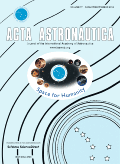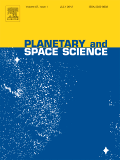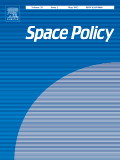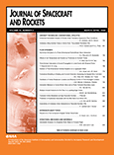
Space: Science & Technology
Scope & Guideline
Elevating Research Standards in Space Sciences
Introduction
Aims and Scopes
- Space Exploration and Planetary Science:
Research focusing on the exploration of celestial bodies, including the Moon, Mars, and asteroids, with an emphasis on geological studies, resource utilization, and planetary evolution. - Space Robotics and Automation:
Development and application of robotic systems for on-orbit servicing, assembly, and manipulation, addressing challenges such as autonomy, precision, and operational safety. - Satellite Communication and Networking:
Innovations in satellite communication technologies, including the integration of 6G networks, inter-satellite communication algorithms, and the management of mega-constellations. - Spacecraft Dynamics and Control:
Studies on the dynamics, control, and navigation of spacecraft, including trajectory optimization, control strategies, and adaptive systems for various space missions. - Space Medicine and Human Factors:
Exploration of the physiological and psychological effects of space travel on humans, including countermeasures for health risks associated with long-duration missions. - Space Debris Management and Environmental Impact:
Research on the mitigation of space debris, its impact on space operations, and strategies for debris removal and sustainable space practices. - Advanced Materials and Propulsion Systems:
Investigation into new materials and propulsion technologies for space applications, focusing on efficiency, reliability, and performance under extreme conditions.
Trending and Emerging
- In-Situ Resource Utilization (ISRU):
There is a rising focus on technologies and methods for utilizing resources found on celestial bodies, such as the Moon and Mars, to support long-term human presence and reduce reliance on Earth. - Artificial Intelligence and Machine Learning Applications:
The integration of AI and machine learning in space operations, from autonomous navigation to data analysis, is gaining traction, showcasing the potential for enhanced decision-making and efficiency. - Mega-Constellations and Satellite Networks:
Research on the design, deployment, and management of large satellite constellations, particularly for communication and Earth observation, is increasingly prominent as global connectivity demands grow. - Microgravity Research and Life Sciences:
There is a notable increase in studies related to microgravity's effects on biological systems, emphasizing the importance of understanding human health and biological processes in space. - Sustainable Space Practices:
A growing emphasis on sustainable practices in space exploration, including debris mitigation, environmentally friendly technologies, and ethical considerations in space resource utilization, is emerging.
Declining or Waning
- Traditional Space Mission Architectures:
Research related to conventional mission architecture and design is becoming less prominent as innovative approaches and technologies emerge, such as autonomous systems and flexible mission planning. - Basic Theoretical Studies in Astrophysics:
While foundational astrophysics remains important, the journal has seen a decline in purely theoretical studies as more emphasis is placed on applied research and technology-driven investigations. - Static Space Habitats:
The focus on static, non-adaptive space habitats is diminishing in favor of dynamic, modular systems that can adapt to changing conditions and mission requirements. - Conventional Propulsion Technologies:
Interest in traditional propulsion technologies appears to be waning as research shifts towards more advanced and sustainable propulsion methods, such as electric or hybrid systems. - Isolated Planetary Research:
Research that focuses solely on isolated planetary studies without considering broader interplanetary systems or collaborative international efforts is seeing reduced publication frequency.
Similar Journals

ACTA ASTRONAUTICA
Charting New Territories in Space TechnologyACTA ASTRONAUTICA is a premier journal in the field of aerospace engineering, dedicated to advancing knowledge in space exploration and technology. Published by PERGAMON-ELSEVIER SCIENCE LTD in the United Kingdom, this journal boasts a prestigious Q1 ranking within its category as of 2023, positioning it in the top tier of aerospace engineering publications. With an ISSN of 0094-5765 and an E-ISSN of 1879-2030, ACTA ASTRONAUTICA has been a crucial resource for researchers and professionals since its inception in 1974, continuing to publish cutting-edge research through to 2024. The journal focuses on a wide range of topics, from orbital mechanics and spacecraft design to astronautics and planetary science, aiming to inspire innovation and facilitate the exchange of ideas among scholars, industry experts, and students. ACTA ASTRONAUTICA is ranked 19th out of 153 in its field, highlighting its importance and influence within the aerospace community. Researchers seeking a reputable platform to share their findings will find this journal to be an essential part of the academic discourse in aerospace engineering.

PLANETARY AND SPACE SCIENCE
Charting New Frontiers: The Intersection of Space and Planetary SciencePLANETARY AND SPACE SCIENCE is a leading journal dedicated to the interdisciplinary field of astral studies, encompassing both planetary science and the exploration of space. Published by PERGAMON-ELSEVIER SCIENCE LTD in the United Kingdom, this journal has been pivotal since its inception in 1959, continually contributing to advancements in research about planetary bodies, their atmospheres, and the broader cosmic landscape. With an impressive impact factor, PLANETARY AND SPACE SCIENCE ranks in the second quartile of Astronomy and Astrophysics and the third quartile in Space and Planetary Science as of 2023, showcasing its scholarly significance. The journal aims to provide a platform for the dissemination of cutting-edge research, emphasizing the critical role of space exploration and planetary studies in understanding our universe. Researchers, professionals, and students alike are encouraged to explore the wealth of knowledge presented in its pages, fostering a deeper comprehension of the phenomena that shapes both our solar system and beyond.

International Journal of Aeronautical and Space Sciences
Advancing the Frontiers of Aerospace ResearchThe International Journal of Aeronautical and Space Sciences, published by Springer, is a prominent platform dedicated to advancing research and innovation in the fields of Aerospace Engineering, Control and Systems Engineering, Electrical and Electronic Engineering, and Materials Science. With an ISSN of 2093-274X and an E-ISSN of 2093-2480, the journal has established itself as a vital resource since its inception in 2011, currently offering insights that span a wide range of contemporary challenges and technological advancements in aeronautics and space exploration. Ranking in the Q2 category across multiple disciplines, including Aerospace and Control Engineering, signifies its recognized impact and quality within the academic community. Although not an open-access journal, it remains accessible to researchers, professionals, and students seeking to enhance their understanding of complex aerospace systems and their applications. The journal’s commitment to publishing high-quality research makes it indispensable for those aiming to contribute to, or stay informed about, the evolving landscape of aerospace technology.

SPACE POLICY
Pioneering Insights into the Socio-Political Dimensions of Space.SPACE POLICY is a premier academic journal published by Elsevier Science Ltd that focuses on the interdisciplinary field of space policy, exploring the myriad issues that arise in the governance and strategic use of space resources. With an ISSN of 0265-9646 and an E-ISSN of 1879-338X, this journal addresses critical topics pertinent to economics, law, sociology, and political science, making it an essential resource for researchers, policymakers, and academicians. Since its inception in 1985 and continuing through to 2024, SPACE POLICY has garnered strong recognition, achieving Q1 and Q2 rankings in various categories as of 2023, indicating its significant impact in both theoretical and applied research. Although it operates on a subscription basis, the journal's commitment to delivering high-quality, rigorous research ensures it remains at the forefront of discourse on the socio-political implications of space exploration and utilization. Whether you are a seasoned researcher or a student delving into the complexities of space governance, SPACE POLICY provides a vital platform for advancing knowledge and debate in this rapidly evolving field.

Artificial Satellites-Journal of Planetary Geodesy
Innovative Perspectives on Planetary Geodesy and Satellite ApplicationsArtificial Satellites-Journal of Planetary Geodesy is a pivotal academic journal dedicated to the field of planetary geodesy, focusing on the intersection of satellite technology and planetary sciences. Published by SCIENDO, this journal, with an ISSN of 0208-841X and an E-ISSN of 2083-6104, offers comprehensive insights into current research developments through peer-reviewed articles. Operating under an open-access model, the journal is accessible to a wide audience, fostering a collaborative environment among researchers and practitioners worldwide. Established in 2009, it has emerged as a significant resource, ranking in the Q4 category for Space and Planetary Science and recognized in the Scopus database, placing it within the 12th percentile among earth and planetary sciences journals. The journal's objective is to advance knowledge in the application of satellite technology to planetary studies, making it an essential platform for innovative research, methodological advancements, and interdisciplinary dialogues for professionals, researchers, and students in the field.

Aerospace Research in Bulgaria
Elevating aerospace research to new heights.Aerospace Research in Bulgaria is a prestigious academic journal dedicated to advancing the field of aerospace engineering and technology. Published by the BULGARIAN ACADEMY OF SCIENCES, SPACE RESEARCH & TECHNOLOGY INSTITUTE (SRTI-BAS), this journal serves as a key platform for researchers, engineers, and professionals seeking to share original research, innovative technologies, and critical reviews related to aerospace applications. With the ISSN 1313-0927 and E-ISSN 2367-9522, the journal aims to contribute significantly to the global aerospace community. Although the journal operates under a traditional access model, it emphasizes the importance of research collaboration and disseminating knowledge in the ever-evolving aerospace sector. The editorial team is committed to maintaining high standards in peer review, making it an essential resource for academics and practitioners alike. Located at ACAD. GEORGI BONCHEV STR., SOFIA 1113, BULGARIA, this journal not only highlights Bulgarian contributions to aerospace research but also aims to engage with a broader international audience, fostering advances that propel the industry forward.

JOURNAL OF SPACECRAFT AND ROCKETS
Elevating Aerospace Insights to New Heights.The Journal of Spacecraft and Rockets, published by the American Institute of Aeronautics and Astronautics, serves as a premier platform for disseminating cutting-edge research in the fields of aerospace engineering and space science. Established in 1964, this esteemed journal has evolved over nearly six decades, solidifying its reputation with a consistent publication history through 2024. With an impact factor positioning it within the Q2 quartile in both Aerospace Engineering and Space and Planetary Science categories, it ranks as a vital resource, featuring high-quality manuscripts that address the latest advancements and findings in spacecraft design, propulsion systems, and austere planetary exploration. The journal's rigorous peer-review process ensures that articles meet the high academic standards expected by practitioners in the aerospace sector. Researchers, engineers, and students alike will find the Journal of Spacecraft and Rockets to be an invaluable resource for both foundational knowledge and innovative research developments, advancing the future of aeronautics and astronautics.

Space Science and Technology-Kosmicna Nauka i Tehnologia
Connecting minds for a brighter future in space exploration.Space Science and Technology-Kosmicna Nauka i Tehnologia is an esteemed journal dedicated to advancing knowledge in the fields of Aerospace Engineering and Space and Planetary Science. Published by the well-regarded PUBLISHING HOUSE AKADEMPERIODYKA in Ukraine, this journal serves as a vital platform for researchers, professionals, and students to share groundbreaking findings and innovative technologies related to space exploration and engineering techniques. Since its establishment in 2019, Space Science and Technology has contributed significantly to the academic discourse in its category, currently holding a Q4 quartile ranking in both Aerospace Engineering and Space and Planetary Science as of 2023. Although it does not offer open-access publication, its listed ISSN (1561-8889) and E-ISSN (2518-1459) ensure wide accessibility to its published content. As the journal continues its journey from 2019 to 2024, it strives to enhance its impact and H-index while fostering collaboration and knowledge dissemination across the global space science community.

Journal of Aeronautics Astronautics and Aviation
Pioneering Insights in the World of Flight and BeyondJournal of Aeronautics Astronautics and Aviation, published by the Aeronautical & Astronautical Society Republic of China, is a premier scholarly journal dedicated to advancing knowledge in the dynamic fields of aerospace engineering and space sciences. Operating under the ISSN 1990-7710, this journal plays a pivotal role in disseminating innovative research and practice-oriented studies that address both theoretical and applicative aspects of aeronautics and astronautics. With an impressive history spanning from 2006 to 2024, the journal has established itself as a valuable resource for researchers, professionals, and students alike, featuring contributions that reflect the latest developments and trends within the industry. In the latest rankings, it holds a Q3 classification in Aerospace Engineering and Q4 in Space and Planetary Science, indicating its growing influence despite its niche scope. With an open access model that facilitates widespread readership, the Journal of Aeronautics Astronautics and Aviation strives to foster collaboration and knowledge sharing in these ever-evolving scientific domains.

Journal of Space Safety Engineering
Pioneering research for a safer journey into space.The Journal of Space Safety Engineering, published by ELSEVIER, is a pioneering platform dedicated to advancing the field of aerospace safety and engineering. Since its inception in 2014, this journal has catered to researchers and professionals focusing on the crucial intersection of aerospace engineering and safety, risk, reliability, and quality management. With an ISSN of 2468-8975 and E-ISSN of 2468-8967, it has established itself within the academic community, currently holding a Q3 ranking in both Aerospace Engineering and Safety, Risk, Reliability, and Quality categories, according to the 2023 metrics. The journal, which covers converged years up to 2024, is instrumental for those seeking to explore innovative safety solutions in space missions and exploration, making it an essential resource for students, industry professionals, and researchers alike. Although it is not open access, it remains a credible source of impactful studies that contribute to enhancing safety protocols and engineering practices in aerospace endeavors. With a strong focus on rigorously vetted research, the Journal of Space Safety Engineering ensures that important advancements in this dynamic and vital field are shared widely among experts and stakeholders.